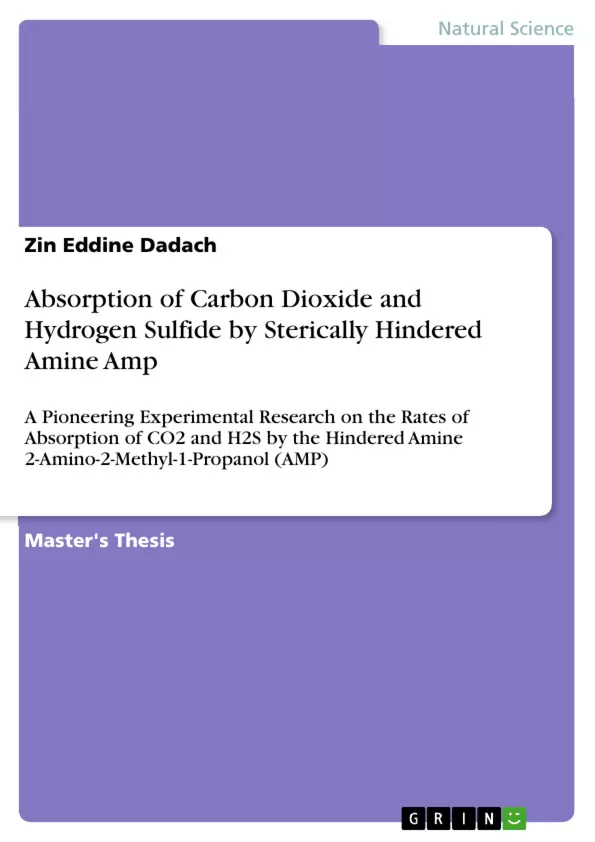In a pioneering research study, experimental data for the absorption rates of CO2, H2S and a mixture of both in hindered amine, 2-amino-2-methyl-1-propanol (AMP) aqueous solutions (0.03M, 0.1M, 0.2M and 0.3M) are presented for the first time. Results are compared with the absorption rate in monoethanolamine (MEA) solutions of similar concentrations. The obtained results describe the conditions under which AMP can be a better solvent than MEA and mention the opposing factors of the absorption of CO2 by the steric hindrance effect of AMP and the concentration of the unstable carbamate.
Inhaltsverzeichnis (Table of Contents)
- INTRODUCTION
- THEORY OF ABSORPTION
- First-order reaction
- Instantaneous reaction
- Second-order reaction
- CHEMICAL REACTIONS AND KINETICS
- Carbon dioxide in pure water
- Carbon dioxide in amine solutions
- Hydrogen sulfide in amine solutions
- Carbon dioxide/hydrogen sulfide mixture in amine solutions
- DESCRIPTION OF THE APPARATUS & OPERATING PROCEDURE
- Description of the laboratory rig
- Calibration and leak tests
- Experimental Procedure
- REPRODUCIBILITY OF THE EXPERIMENTAL APPARATUS
- ABSORPTION OF CARBON DIOXIDE INTO AMINE SOLUTIONS.
- Experimental investigation for the hindered amine AMP
- Experimental investigation for the classical amine MEA
- Analysis of Data and Discussion
- Effects of partial pressure of CO2 on the Absorption Rates
- Effects of the Concentration of Amines on the Absorption rates
- Comparing the amount of CO2 absorbed in AMP and MEA amine solutions
- ABSORPTION OF HYDROGEN SULPHIDE INTO AMINE SOLUTIONS
- Absorption of the hydrogen sulfide by the hindered amine AMP
- Absorption of the hydrogen sulfide by the classical amine MEA
- Analysis of Data and Discussion
- Effects of the concentration of amine on the rate of absorption
- Effects of partial pressure of H2S on the Absorption rates
- Comparing the amount of H2S absorbed in AMP and MEA amine solutions
- SIMULTANEOUS ABSORPTION OF CO2 AND H2S INTO AMINE SOLUTIONS
- Absorption of the mixture (CO2 + H2S)
- Competitive absorption of CO2 and H2S in the hindered amine AMP
- Competitive absorption of CO2 and H2S in the hindered amine AMP
Zielsetzung und Themenschwerpunkte (Objectives and Key Themes)
This master thesis aims to investigate the rates of absorption of carbon dioxide and hydrogen sulfide by the hindered amine AMP. The research compares the absorption rates in AMP solutions with those of MEA solutions. The study explores the conditions under which AMP may be a more effective solvent than MEA, considering the steric hindrance effect of AMP on the absorption of CO2 and the concentration of the unstable carbamate.
- Rates of absorption of CO2 and H2S by the hindered amine AMP
- Comparison of absorption rates in AMP and MEA solutions
- Steric hindrance effect of AMP on CO2 absorption
- Concentration of unstable carbamate
- Conditions for AMP to be a more effective solvent than MEA
Zusammenfassung der Kapitel (Chapter Summaries)
- Introduction: This chapter sets the stage for the research by outlining the importance of gas absorption processes and highlighting the specific focus on CO2 and H2S absorption in amine solutions. It introduces the hindered amine AMP and its potential advantages compared to traditional amines like MEA.
- Theory of Absorption: This chapter provides a theoretical foundation for the gas absorption process. It explains the different mechanisms involved, including physical absorption and absorption accompanied by chemical reactions. The concept of the enhancement factor, which quantifies the impact of chemical reactions on absorption rates, is introduced.
- Chemical Reactions and Kinetics: This chapter delves into the chemical reactions involved in the absorption of CO2 and H2S by amine solutions. It discusses the reactions of CO2 in pure water and in amine solutions, highlighting the formation of carbamates and their impact on the absorption capacity. The reactions of H2S with amine solutions are also presented, emphasizing their instantaneous nature.
- Description of the Apparatus & Operating Procedure: This chapter details the laboratory rig used for the experimental investigations. It explains the apparatus's components, including the absorption cell, gas storage cylinder, and pressure monitoring systems. The calibration and leak tests conducted to ensure the accuracy of the experimental setup are also described.
- Reproducibility of the Experimental Apparatus: This chapter validates the experimental apparatus by testing the absorption of CO2 in pure water. The results are compared to theoretical predictions, demonstrating the apparatus's reproducibility and reliability.
- Absorption of Carbon Dioxide into Amine Solutions: This chapter presents the experimental results of CO2 absorption by AMP and MEA solutions at different partial pressures and amine concentrations. The chapter analyzes the data, discussing the impact of partial pressure and concentration on the absorption rates.
- Absorption of Hydrogen Sulfide into Amine Solutions: This chapter investigates the absorption of H2S by AMP and MEA solutions at different concentrations and partial pressures. It explores the relationship between the amount of H2S absorbed and the amine concentration, as well as the effects of varying the partial pressure of H2S.
- Simultaneous Absorption of CO2 and H2S into Amine Solutions: This chapter investigates the absorption of mixtures of CO2 and H2S by AMP and MEA solutions. It analyzes the competitive absorption of CO2 and H2S, considering the impact of different gas compositions on the overall absorption process.
Schlüsselwörter (Keywords)
This thesis focuses on the absorption of CO2 and H2S by hindered amine AMP and MEA solutions. The study examines the steric hindrance effect of AMP on the absorption of CO2, the stability of carbamates, and the conditions under which AMP can be a more effective solvent than MEA. Key concepts explored include gas absorption rates, chemical reactions, reaction kinetics, enhancement factors, and the impact of partial pressure and amine concentration on the absorption process.
- Citar trabajo
- Zin Eddine Dadach (Autor), 1984, Absorption of Carbon Dioxide and Hydrogen Sulfide by Sterically Hindered Amine Amp, Múnich, GRIN Verlag, https://www.grin.com/document/309149



